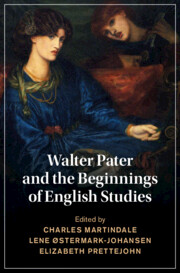Book contents
- Walter Pater and the Beginnings of English Studies
- Cambridge Studies in Nineteenth-Century Literature and Culture
- Walter Pater and the Beginnings of English Studies
- Copyright page
- Contents
- Figures
- Contributors
- Preface
- Abbreviations
- Introduction: Pater and English Literature
- Part I General
- Part II Individual Authors: Early Moderns, Romantics, Contemporaries
- Introduction to Part II
- Chapter 8 Pater’s Shakespeare
- Chapter 9 Pater and the Quaintness of Seventeenth-Century English Prose
- Chapter 10 ‘Spiritual Form’: Walter Pater’s Encounters with William Blake
- Chapter 11 Pater on Coleridge and Wordsworth
- Chapter 12 Walter Pater, Charles Lamb, and ‘the value of reserve’
- Chapter 13 Poetry in Dilution: Pater, Morris, and the Future of English
- Chapter 14 Dante Gabriel Rossetti and His School
- Postscript
- Walter Pater and English Studies: A Select Bibliography
- Index
- Cambridge Studies in Nineteenth-Century Literature and Culture
Chapter 9 - Pater and the Quaintness of Seventeenth-Century English Prose
from Part II - Individual Authors: Early Moderns, Romantics, Contemporaries
Published online by Cambridge University Press: 14 November 2023
- Walter Pater and the Beginnings of English Studies
- Cambridge Studies in Nineteenth-Century Literature and Culture
- Walter Pater and the Beginnings of English Studies
- Copyright page
- Contents
- Figures
- Contributors
- Preface
- Abbreviations
- Introduction: Pater and English Literature
- Part I General
- Part II Individual Authors: Early Moderns, Romantics, Contemporaries
- Introduction to Part II
- Chapter 8 Pater’s Shakespeare
- Chapter 9 Pater and the Quaintness of Seventeenth-Century English Prose
- Chapter 10 ‘Spiritual Form’: Walter Pater’s Encounters with William Blake
- Chapter 11 Pater on Coleridge and Wordsworth
- Chapter 12 Walter Pater, Charles Lamb, and ‘the value of reserve’
- Chapter 13 Poetry in Dilution: Pater, Morris, and the Future of English
- Chapter 14 Dante Gabriel Rossetti and His School
- Postscript
- Walter Pater and English Studies: A Select Bibliography
- Index
- Cambridge Studies in Nineteenth-Century Literature and Culture
Summary
This chapter aims to expose what ‘quaint’ means for Pater, and the work it does in his criticism. His use of ‘quaint’ is idiosyncratic but connected to a wider pattern in criticism: on the one hand, the attempt of his predecessors and contemporaries to account for Browne’s peculiarity; on the other, a vogue for the word as a critical term with strong and ambivalent associations. It is a keyword, marking a simultaneous discomfort with and interest in the lingering appeal of outmoded aesthetic objects which connects it to Pater’s broader theoretical statements on style, and on the relationship between Classicism and Romanticism. The chapter shows how Pater’s quaintness fits in the longer history of the reception of Browne, which traces changing attitudes to difficulty, Latinity, and ‘metaphysical’ style. These qualities were associated with forms of religion and philosophical education rejected in the later seventeenth century, just as ‘classical clearness’ became the ideal of prose, and they have remained variously embarrassing, threatening, or appealing ever since: a complex of aesthetic effects which ‘quaint’ works both to name and conceal.
- Type
- Chapter
- Information
- Walter Pater and the Beginnings of English Studies , pp. 176 - 197Publisher: Cambridge University PressPrint publication year: 2023



